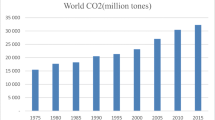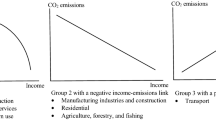Abstract
This paper analyses the forces driving energy-related CO2 emissions based on a threshold STIRPAT dynamic model, using Chinese state-level panel data during the period of 1997 to 2010. In addition to investigating the impact of affluence on CO2 emissions, this paper studies channels through which affluence could impact on CO2 emissions across development levels and explores the possibility of reducing CO2 emissions through greater affluence by analysing panels including all regions, high-income regions and low-income regions. A threshold STIRPAT dynamic model further estimates thresholds for the major determinants of CO2 emissions: in the long run, affluence is the most important determinant followed by urban population. Variability of affluence impact on CO2 emissions in high-income regions is explained mostly by trade openness degree, while low-income regions with a higher industrial level are associated with lower CO2 emissions. Different measures should be adopted for CO2 reductions in different regions according to local conditions.




Similar content being viewed by others
References
Aşici, A. A. (2013). Economic growth and its impact on environment: a panel data analysis. Ecological Indicators, 24(1), 324–333.
Arellano, M., & Bover, O. (1995). Another look at the instrumental variable estimation of error-component models. Journal of Econometrics, 68(1), 29–51.
Blundell, R., & Bond, S. (1998). Initial conditions and moment restrictions in dynamic panel data models. Journal of Econometrics, 87(1), 115–143.
Bongaarts, J. (1992). Population growth and global warming. Population and Development Review, 18, 299–319.
Carson, R. (2010). The Environmental Kuznets Curve: seeking empirical regularity and theoretical structure. Review of Environmental Economics and Policy, 4(1), 3–23.
Chertow, M. (2001). The IPAT equation and its variants: changing views of technology and environmental impact. Journal of Industrial Ecology, 4(4), 13–29.
Commoner, B. (1971). The closing circle: Nature, man, and technology (1st ed.). New York: Alfred Knopf.
Commoner, B. (1972). The environmental cost of economic growth, in population, resources and the environment (pp. 339–363). Washington, DC: GPO.
Cramer, J. C. (1998). Population growth and air quality in California. Demography, 35(1), 45–56.
Dietz, T., & Rosa, E. A. (1994). Rethinking the environmental impacts of population, affluence and technology. Human Ecology Review, 1, 277–300.
Dietz, T., & Rosa, E. A. (1997). Effects of population and affluence on CO2 emissions. Proceedings of the National Academy of Sciences of the United States of America, 94, 175–179.
Du, L. M., Wei, C., & Cai, S. H. (2012). Economic development and carbon dioxide emissions in China: provincial panel data analysis. China Economic Review, 23(2), 371–384.
Ehrlich, P., & Holdren, J. (1971). The impact of population growth. Science, 171, 1212–1217.
Ehrlich, P., & Holdren, J. (1972). One-dimensional economy. Bulletin of the atomic scientists, 28, 16–27.
Fan, Y., Liu, L. C., Wu, G., & Wei, Y. M. (2006). Analyzing impact factors of CO2 emissions using the STIRPAT model. Environmental Impact Assessment Review, 26(4), 377–395.
Fischer-Kowalski, M., & Amman, C. (2001). Beyond IPAT and Kuznets curves: globalization as a vital factor in analyzing environmental impact of socioeconomic metabolism. Population and Environment, 23(1), 7–47.
Friedl, B., & Getzner, M. (2003). Determinants of CO2 emissions in a small open economy. Ecological Economics, 45(1), 133–148.
Grossman, G. M., Krueger, A. B. (1991). Environmental impacts of the North American Free Trade Agreement. NBER. Working paper 3914.
Hansen, B. E. (2000). Sample splitting and threshold estimation. Econometrica, 68(3), 575–603.
Hayakawa, K. (2007). Small sample bias properties of the system GMM estimator in dynamic panel models. Economics Letters, 95(1), 32–38.
IPCC. (2006). 2006 IPCC Guidelines for National Greenhouse Gas Inventories.
Jia, J. S., Deng, H. B., Duan, J., & Zhao, J. Z. (2009). Analysis of the major drivers of the ecological footprint using the STIRPAT model and the PLS method-a case study in Henan Province, China. Ecological Economics, 68, 2818–2824.
Liddle, B. (2012). What are the carbon emissions elasticities for income and population? A robustness exercise employing the STIRPAT framework. USAEE Working Paper No. 12–135. Available via SSRN. http://ssrn.com/abstract=2162222.
Levin, A., Lin, C.-F., & Chia-Shang, J. C. (2002). Unit root tests in panel data: Asymptotic and finite sample properties. Journal of Econometrics, 108(1), 1–24. Levin A, Lin C-F, Chia-Shang JC, 2002. Unit root tests in panel data: Asymptotic and finite sample properties. Journal of Econometrics 108(1), 1–24.
Liddle, B. (2013). The energy, economic growth, urbanization nexus across development: evidence from heterogeneous panel estimates robust to cross-sectional dependence. The Energy Journal, 34(2), 223–244.
Liddle, B. (2013). Population, affluence, and environmental impact across development: evidence from panel cointegration modeling. Environmental Modelling & Software, 40(2), 255–266.
Liddle, B. (2013). Urban density and climate change: a STIRPAT analysis using city-level data. Journal of Transport Geography, 28(3), 22–29.
Liddle, B., & Lung, S. (2013). The long-run causal relationship between transport energy consumption and GDP: evidence from heterogeneous panel methods robust to cross-sectional dependence. Economics Letters, 121(3), 524–527.
Li, G. Z., & Li, Z. Z. (2010). Regional difference and influence factors of China’s carbon dioxide emissions. China Population, Resources and Environment, 20(5), 22–27.
Narayan, P., Smyth, R., & Prasad, A. (2007). Electricity consumption in G7 countries: a panel cointegration analysis of residential demand elasticities. Energy Policy, 35(9), 4485–4494.
O’Neill, B., Liddle, B., Jiang, L., Smith, K., Pachauri, S., Dalton, M., & Fuchs, R. (2012). Demographic change and carbon dioxide emissions. The Lancet, 380(9837), 157–164.
Pesaran, M. H. (2007). A simple panel unit root test in the presence of cross-section dependence. Journal of Applied Econometrics, 22(2), 265–312.
Roodman, D. (2006). How to do xtabond2: an introduction to difference and system GMM in Stata. The Stata Journal, 9(1), 86–136.
Schulze, P. C. (2002). I = PBAT. Ecological Economics, 40(2), 149–150.
Shi, A. (2003). The impact of population pressure on global carbon dioxide emissions, 1975–1996: evidence from pooled cross-country data. Ecological Economics, 44, 29–42.
Shao, S., Yang, L., & Cao, J. (2010). Study on influencing factors of CO2 emissions from industrial energy consumption. Journal of Finance and Economics, 36(11), 16–27.
Shao, S., Yang, L. L., Yu, M. B., & Yu, M. L. (2011). Estimation, characteristics, and determinants of energy-related industrial CO2 emissions in Shanghai(China), 1994–2009. Energy Policy, 39(10), 6476–6494.
Song, M.-L., Zhang, W., & Wang, W.-J. (2013). Inflection point of environmental Kuznets curve in Mainland China. Energy Policy, 57(6), 14–20. doi:10.1007/s10666-014-9424-4
Squalli, J. (2010). An empirical assessment of U.S. state-level immigration and environmental emissions. Ecological Economics, 69(5), 1170–1175.
Stern, D. (2010). Between estimates of the emissions-income elasticity. Ecological Economics, 69, 2173–2182.
Tyler, D. R. (2011). Applying the STIRPAT model in a post-Fordist landscape: can a traditional econometric model work at the local level? Applied Geography, 31(2), 731–739.
Waggoner, P. E., & Ausubel, J. H. (2002). A framework for sustainability science: a renovated IPAT identity. Proceedings of the National Academy of Sciences of the USA, 99(12), 7860–7865.
Wagner, M. (2008). The carbon Kuznets curve: a cloudy picture emitted by bad econometrics? Resource and Energy Economics, 30(3), 388–408.
Wang, H. S., Lei, Y., Wang, H. K., Liu, M. M., Yang, J., & Bi, J. (2013). Carbon reduction potentials of China’s industrial parks: a case study of Suzhou Industry Park. Energy, 55, 668–675.
Wang, P., Wu, W. S., Zhu, B. Z., & Wei, Y. M. (2013). Examining the impact factors of energy-related CO2 emissions using the STIRPAT model in Guangdong Province, China. Applied Energy, 106(6), 65–71.
Wang, M. W., Che, Y., Yang, K., Wan, M., Xiong, L. J., & Huang, Y. C. (2011). A local-scale low-carbon plan based on the STIRPAT model and the scenario method: the case of Minhang District, Shanghai, China. Energy Policy, 39(11), 6981–6990.
Wang, Z. H., Yin, F. C., Zhang, Y. X., & Zhang, X. (2012). An empirical research on the influencing factors of regional emissions: evidence from Beijing city, China. Applied Energy, 100(12), 277–284.
Westerlund, J. (2007). Testing for error correction in panel data. Oxford Bulletin of Economics and Statistics, 69(6), 709–748.
Windmeijer, F. (2005). A finite sample correction for the variance of linear efficient two-step GMM estimators. Journal of Econometrics, 126(1), 25–51.
York, R., Rosa, E., & Dietz, T. (2003). Footprints on the earth: the environmental consequences of modernity. American Sociological Review, 68, 279–300.
York, R., Rosa, E., & Dietz, T. (2003). A rift in modernity? Assessing the anthropogenic sources of global climate change with the STIRPAT model. International Journal of Sociology and Social Policy, 23, 31–51.
York, R., Rosa, E., & Dietz, T. (2003). STIRPAT, IPAT, and ImPACT: analytic tools for unpacking the driving forces of environmental impacts. Ecological Economics, 46, 351–365.
Zhao, C. S., Niu, S. W., & Zhang, X. (2012). Effects of household energy consumption on environment and its influence factors in rural and urban areas. Energy Procedia, 14, 805–818.
Zhang, C. G., & Lin, Y. (2012). Panel estimation for urbanisation, energy consumption and CO2 emissions: a regional analysis in China. Energy Policy, 49(10), 488–498.
Acknowledgments
We acknowledge the financial support from the National Natural Science Foundation of China (grant no. 71373172) and the Independent Innovation Foundation of Tianjin University (grant no. 60304002). We especially thank the anonymous reviewers for their insightful comments and suggestions. All remaining errors are ours.
Author information
Authors and Affiliations
Corresponding author
Appendix
Appendix
Rights and permissions
About this article
Cite this article
Yuan, R., Zhao, T., Xu, X. et al. Regional Characteristics of Impact Factors for Energy-Related CO2 Emissions in China, 1997–2010: Evidence from Tests for Threshold Effects Based on the STIRPAT Model. Environ Model Assess 20, 129–144 (2015). https://doi.org/10.1007/s10666-014-9424-4
Received:
Accepted:
Published:
Issue Date:
DOI: https://doi.org/10.1007/s10666-014-9424-4




